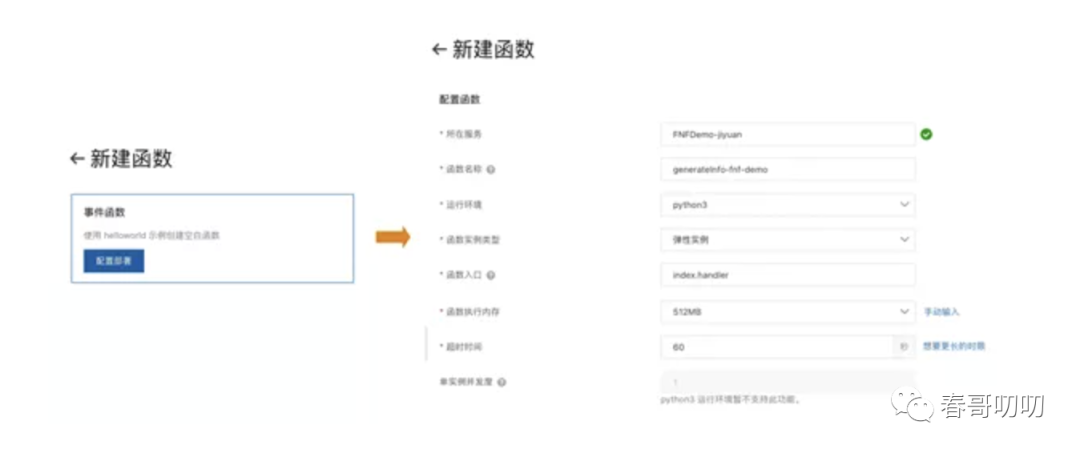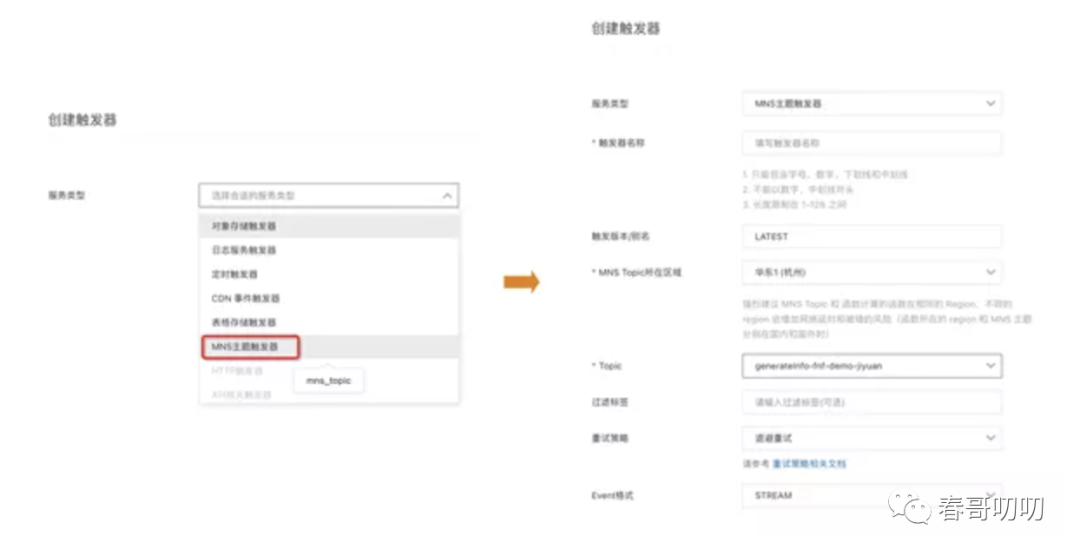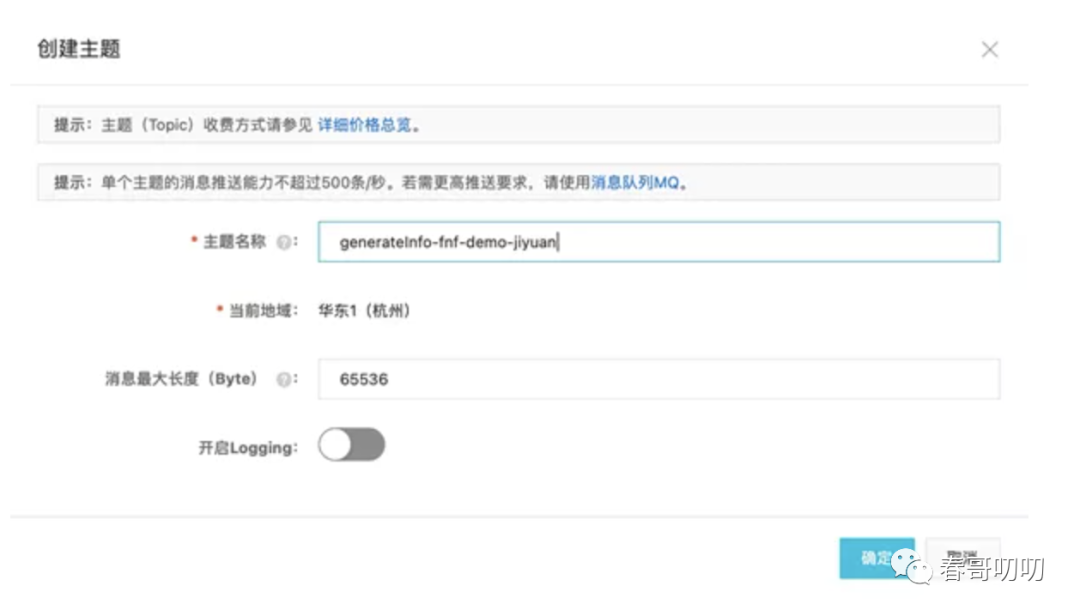余光
楼主
发布于 2023-6-6 17:42:57
阅读 2423
查看全部
简介: 搭建一个 aPaaS 平台是需要很长时间的,当然也可以基于一些公有云产品的 Serverless 方案实现现有系统的灵敏性与扩展性,从而实现针对于不同客户的定制。写在前面 Serverless 方案 实现现有系统的灵敏性与扩展性,从而实现针对于不同客户的定制。什么是 Serverless 前者可以理解为其处置方案范围处在效劳端;后者可以译为少量的; 组合起来就是较少效劳端干预的效劳端处置方案。Serverfull 时代 ,研发交付流程一般有三个角色:RD,PM,QA。DevOps 时代 。这个时代运维自己开发一套运维控制台,可以让研发同学在控制台上自己停止效劳观测、数据查询、运维处置等,运维同学的工作轻松了不少,这个阶段主要释放了运维同学的人力。Serverless 时代 ,这套运维控制台才干越来越丰富,可以实现按配置的自动扩缩容、性能监控、DevOps 流水线等,同时侵入到研发流程侧,比如自动发布流水线、编译打包、代码质量监测、灰度发布、弹性扩缩等流程根本不需要人力处置了,这就是 Serverless 时代。Serverless 怎么用 写的是代码块,代码数量不会特别大;代码运行速度快;支持多种编程语言;可以支持不可估计的流量洪峰冲击。 以阿里云处置方案看下如何支持多语言架构:Serverless 怎么做 如何调用 FC 的函数 ,一般的 FC 处置方案里面都有一个触发器的概念。比如 HTTP 触发器、对象存储触发器、日志效劳触发器、定时任务触发器、CDN 触发器、消息队列触发器等。触发器是对于 FC 函数调用的笼统收口,比如 HTTP 触发器一般都类比网关的一个 http 恳求事件,或是指定对象存储途径下上传了一个图片,这些触发事件的入口都可以是触发器。那么 FC 是如何实现高可用的呢? 给函数设置并发实例数,比如 3 个,那么当有三个恳求进来时,该函数只启动一个实例,但是会启动三个线程来运行逻辑;线程到达上限后,会再拉起一个函数实例。 类似于线程池的方案。那么 Serverless 如何提效呢? 效率高 :假设新加了语言,只需要创建一个对应的 Runtime 的 FC 函数即可;高可用 :通过多线程、多实例两种方式保证高可用,且函数实例扩缩容完全由 FC 自助处置,不需要运维做任何配置;本钱低 :在没有触发器恳求时,函数实例不会被拉起,也不会计费,所以在流量低谷期间或者夜间时,FC 消耗的本钱是非常低的。如何在云平台创建一个 FC 1. 创建效劳 首先新建一个效劳名称;选定效劳部署的地区(背后协助你就近部署在目的机房);选择是否翻开调试日志(开发过程开启,线上运行时可关闭)。 2. 创建函数 选择函数绑定的效劳;设置函数名称;选择 runtime 环境;是否要求函数实例弹性;函数入口(触发器直接调用的目的方法);函数执行内存;函数执行超时时间;设置实例并发度。 3. 代码编写
# -*- coding: utf-8 -*- import logging import urllib.parse import time import subprocess def handler(environ, start_response): context = environ['fc.context'] request_uri = environ['fc.request_uri'] for k, v in environ.items(): if k.startswith('HTTP_'): pass try: request_body_size = int(environ.get('CONTENT_LENGTH', 0)) except (ValueError): request_body_size = 0 # 获取用户传入的code request_body = environ['wsgi.input'].read(request_body_size) codeStr = urllib.parse.unquote(request_body.decode("GBK")) # 因为body里的对象里有code和input两个属性,这里分别获取用户code和用户输入 codeArr = codeStr.split('&') code = codeArr[0][5:] inputStr = codeArr[1][6:] # 将用户code保管为py文件,放/tmp目录下,以时间戳为文件名 fileName = '/tmp/' + str(int(time.time())) + '.py' f = open(fileName, "w") # 这里预置引入了time库 f.write('import time \r\n') f = open(fileName, "a") f.write(code) f.close() # 创建子进程,执行方才保管的用户code py文件 p = subprocess.Popen("python " + fileName, stdout=subprocess.PIPE, stdin=subprocess.PIPE, stderr=subprocess.PIPE, shell=True, encoding='utf-8') # 通过规范输入传入用户的input输入 if inputStr != '' : p.stdin.write(inputStr + "\n") p.stdin.flush() # 通过规范输出获取代码执行结果 r = p.stdout.read() status = '200 OK' response_headers = [('Content-type', 'text/plain')] start_response(status, response_headers) return [r.encode('UTF-8')] 复制代码 前端传入代码片段,格式是字符串;在 FC 函数中获取到传入的代码字符串,截取 code 内容和 input 内容;将代码保管为一个 py 文件,以时间戳为文件命名,保管在 FC 函数的 /tmp 目录下,每个函数有自己独立的 /tmp 目录;import time 库代码;通过 subprocess 创建子流程,以 shell 方式通过 py 命令执行保管在 /tmp 目录下的 py 文件;最后读取执行结果返回给前端。 前端调用 FC 函数:用 Serverless 协调工作流 需灵敏配置工作流的业务 流程如何触发的呢? @Configuration public class FNFConfig { @Bean public IAcsClient createDefaultAcsClient(){ DefaultProfile profile = DefaultProfile.getProfile( "cn-xxx", // 地域ID "ak", // RAM 账号的AccessKey ID "sk"); // RAM 账号Access Key Secret IAcsClient client = new DefaultAcsClient(profile); return client; } } 复制代码 输入要启动的流程名称,比如每次订单编号作为启动流程实例名称;流程启动后的流程实例名称;启动输入参数,比如业务参数,比如一个 json 里面有商品、商家、地址、订单等上下文信息。 @GetMapping("/startFNF/{fnfname}/{execuname}/{input}") public StartExecutionResponse startFNF(@PathVariable("fnfname") String fnfName, @PathVariable("execuname") String execuName, @PathVariable("input") String inputStr) throws ClientException { JSONObject jsonObject = new JSONObject(); jsonObject.put("fnfname", fnfName); jsonObject.put("execuname", execuName); jsonObject.put("input", inputStr); return fnfService.startFNF(jsonObject); } 复制代码 @Override public StartExecutionResponse startFNF(JSONObject jsonObject) throws ClientException { StartExecutionRequest request = new StartExecutionRequest(); String orderNum = jsonObject.getString("execuname"); request.setFlowName(jsonObject.getString("fnfname")); request.setExecutionName(orderNum); request.setInput(jsonObject.getString("input")); JSONObject inputObj = jsonObject.getJSONObject("input"); Order order = new Order(); order.setOrderNum(orderNum); order.setAddress(inputObj.getString("address")); order.setProducts(inputObj.getString("products")); order.setSupplier(inputObj.getString("supplier")); orderMap.put(orderNum, order); return iAcsClient.getAcsResponse(request); } 复制代码 第一部分是启动流程;第二部分是创建订单对下,并模仿入库。 前端如何调用? fnfname:要启动的流程名称;execuname:随机生成 uuid,作为订单的编号,也作为启动流程实例的名称;input:将商品、商家、订单号、地址构建为 JSON 字符串传入流程。 submitOrder(){ const orderNum = uuid.v1() this.$axios.$get('/startFNF/OrderDemo-Jiyuan/'+orderNum+'/{\n' + ' "products": "'+this.products+'",\n' + ' "supplier": "'+this.supplier+'",\n' + ' "orderNum": "'+orderNum+'",\n' + ' "address": "'+this.address+'"\n' + '}' ).then((response) => { console.log(response) if(response.message == "success"){ this.$router.push('/orderdemo/' + orderNum) } }) } 复制代码 1. generateInfo 节点 - type: task name: generateInfo timeoutSeconds: 300 resourceArn: acs:mns:::/topics/generateInfo-fnf-demo-jiyuan/messages pattern: waitForCallback inputMappings: - target: taskToken source: $context.task.token - target: products source: $input.products - target: supplier source: $input.supplier - target: address source: $input.address - target: orderNum source: $input.orderNum - target: type source: $context.step.name outputMappings: - target: paymentcombination source: $local.paymentcombination - target: orderNum source: $local.orderNum serviceParams: MessageBody: $ Priority: 1 catch: - errors: - FnF.TaskTimeout goto: orderCanceled ``` - name:节点名称; - timeoutSeconds:超时时间,节点等待时长,超越时间后跳转到 goto 分支指向的 orderCanceled 节点; - pattern:设置为 waitForCallback,表示需要等待确认; - inputMappings:该节点入参; - taskToken:Serverless 工作流自动生成的 Token; - products:选择的商品; - supplier:选择的商家; - address:送餐地址; - orderNum:订单号; - outputMappings:该节点的出参; - paymentcombination:该商家支持的支付方式; - orderNum:订单号; - catch:捕获异常,跳转到其他分支。 Serverless 工作流支持多个云效劳集成,将其他效劳作为任务步骤的执行单元。效劳集成方式通过 FDL 表达式实现,在任务步骤中,可以使 用resourceArn 来定义集成的目的效劳,使用 pattern 定义集成形式。 在 resourceArn 中配置 /topics/generateInfo-fnf-demo-jiyuan/messages 信息,就是集成了 MNS 消息队列效劳,当 generateInfo 节点触发后会向 generateInfo-fnf-demo-jiyuanTopic 中发送一条消息。消息的正文和参数在 serviceParams 对象中 zhi'd 指定。MessageBody 是消息正文,配置 $ 表示通过输入映射 inputMappings 产生消息正文。 generateInfo-fnf-demo 函数: 向 generateInfo-fnf-demo-jiyuanTopic 中发送的这条消息包含了商品信息、商家信息、地址、订单号,表示一个下订单流程的开端,既然有发消息,那么必然有接受消息停止后续处置。在函数计算控制台,创建效劳,在效劳下创建名为 generateInfo-fnf-demo 的事件触发器函数,这里选择 Python Runtime:  创建 MNS 触发器,选择监听 generateInfo-fnf-demo-jiyuanTopic:  翻开消息效劳 MNS 控制台,创建 generateInfo-fnf-demo-jiyuanTopic:  接下来写函数代码: 复制代码 -- coding: utf-8 - - 1. 构建Serverless工作流Client region = "cn-hangzhou" account_id = "XXXX" ak_id = "XXX" ak_secret = "XXX" fnf_client = AcsClient( ak_id, ak_secret, region ) logger = logging.getLogger() # 2. event内的信息即接受到Topic generateInfo-fnf-demo-jiyuan中的消息内容,将其转换为Json对象 bodyJson = json.loads(event) logger.info("products:" + bodyJson["products"]) logger.info("supplier:" + bodyJson["supplier"]) logger.info("address:" + bodyJson["address"]) logger.info("taskToken:" + bodyJson["taskToken"]) supplier = bodyJson["supplier"] taskToken = bodyJson["taskToken"] orderNum = bodyJson["orderNum"] # 3. 判断什么商家使用什么样的支付方式组合,这里的示例比较简单粗暴,正常情况下,应该使用元数据配置的方式获取 paymentcombination = "" if supplier == "haidilao": paymentcombination = "zhifubao,weixin" else: paymentcombination = "zhifubao,weixin,unionpay" # 4. 调用Java效劳暴露的接口,更新订单信息,主要是更新支付方式 url = "http://xx.xx.xx.xx:8080/setPaymentCombination/" + orderNum + "/" + paymentcombination + "/0" x = requests.get(url) # 5. 给予generateInfo节点响应,并返回数据,这里返回了订单号和支付方式 output = "{"orderNum": "%s", "paymentcombination":"%s" " \ "}" % (orderNum, paymentcombination) request = ReportTaskSucceededRequest.ReportTaskSucceededRequest() request.set_Output(output) request.set_TaskToken(taskToken) resp = fnf_client.do_action_with_exception(request) return 'hello world' 复制代码 代码分五部分: - 构建 Serverless 工作流 Client; - event 内的信息即接受到 TopicgenerateInfo-fnf-demo-jiyuan 中的消息内容,将其转换为 Json 对象; - 判断什么商家使用什么样的支付方式组合,这里的示例比较简单粗暴,正常情况下,应该使用元数据配置的方式获取。比如在系统内有商家信息的配置功能,通过在界面上配置该商家支持哪些支付方式,形成元数据配置信息,提供查询接口,在这里停止查询; - 调用 Java 效劳暴露的接口,更新订单信息,主要是更新支付方式; - 给予 generateInfo 节点响应,并返回数据,这里返回了订单号和支付方式。因为该节点的 pattern 是 waitForCallback,所以需要等待响应结果。 generateInfo-fnf-demo 函数配置了 MNS 触发器,当 TopicgenerateInfo-fnf-demo-jiyuan 有消息后就会触发执行 generateInfo-fnf-demo 函数。 ### 2. payment 节点 接下来是 payment 的 FDL 代码定义: 复制代码 type: tasktarget: taskTokenerrors:FnF.TaskTimeout
# -*- coding: utf-8 -*- import logging import json import os import time import logging from aliyunsdkcore.client import AcsClient from aliyunsdkcore.acs_exception.exceptions import ServerException from aliyunsdkcore.client import AcsClient from aliyunsdkfnf.request.v20190315 import ReportTaskSucceededRequest from aliyunsdkfnf.request.v20190315 import ReportTaskFailedRequest from mns.account import Account # pip install aliyun-mns from mns.queue import * def handler(event, context): logger = logging.getLogger() region = "xxx" account_id = "xxx" ak_id = "xxx" ak_secret = "xxx" mns_endpoint = "http://your_account_id.mns.cn-hangzhou.aliyuncs.com/" queue_name = "payment-queue-fnf-demo" my_account = Account(mns_endpoint, ak_id, ak_secret) my_queue = my_account.get_queue(queue_name) # my_queue.set_encoding(False) fnf_client = AcsClient( ak_id, ak_secret, region ) eventJson = json.loads(event) isLoop = True while isLoop: try: recv_msg = my_queue.receive_message(30) isLoop = False # body = json.loads(recv_msg.message_body) logger.info("recv_msg.message_body:======================" + recv_msg.message_body) msgJson = json.loads(recv_msg.message_body) my_queue.delete_message(recv_msg.receipt_handle) # orderCode = int(time.time()) task_token = eventJson["taskToken"] orderNum = eventJson["orderNum"] output = "{"orderNum": "%s", "paymentMethod": "%s", "price": "%s" " \ "}" % (orderNum, msgJson["paymentMethod"], msgJson["price"]) request = ReportTaskSucceededRequest.ReportTaskSucceededRequest() request.set_Output(output) request.set_TaskToken(task_token) resp = fnf_client.do_action_with_exception(request) except Exception as e: logger.info("new loop") return 'hello world' 复制代码
# -*- coding: utf-8 -*- import logging import urllib.parse import json from mns.account import Account # pip install aliyun-mns from mns.queue import * HELLO_WORLD = b'Hello world!\n' def handler(environ, start_response): logger = logging.getLogger() context = environ['fc.context'] request_uri = environ['fc.request_uri'] for k, v in environ.items(): if k.startswith('HTTP_'): # process custom request headers pass try: request_body_size = int(environ.get('CONTENT_LENGTH', 0)) except (ValueError): request_body_size = 0 request_body = environ['wsgi.input'].read(request_body_size) paymentMethod = urllib.parse.unquote(request_body.decode("GBK")) logger.info(paymentMethod) paymentMethodJson = json.loads(paymentMethod) region = "cn-xxx" account_id = "xxx" ak_id = "xxx" ak_secret = "xxx" mns_endpoint = "http://your_account_id.mns.cn-hangzhou.aliyuncs.com/" queue_name = "payment-queue-fnf-demo" my_account = Account(mns_endpoint, ak_id, ak_secret) my_queue = my_account.get_queue(queue_name) output = "{"paymentMethod": "%s", "price":"%s" " \ "}" % (paymentMethodJson["paymentMethod"], paymentMethodJson["price"]) msg = Message(output) my_queue.send_message(msg) status = '200 OK' response_headers = [('Content-type', 'text/plain')] start_response(status, response_headers) return [HELLO_WORLD] 复制代码
3. paymentCombination 节点 - type: choice name: paymentCombination inputMappings: - target: orderNum source: $local.orderNum - target: paymentMethod source: $local.paymentMethod - target: price source: $local.price - target: taskToken source: $local.taskToken choices: - condition: $.paymentMethod == "zhifubao" steps: - type: task name: zhifubao resourceArn: acs:fc:cn-hangzhou:your_account_id:services/FNFDemo-jiyuan/functions/zhifubao-fnf-demo inputMappings: - target: price source: $input.price - target: orderNum source: $input.orderNum - target: paymentMethod source: $input.paymentMethod - target: taskToken source: $input.taskToken - condition: $.paymentMethod == "weixin" steps: - type: task name: weixin resourceArn: acs:fc:cn-hangzhou:your_account_id:services/FNFDemo-jiyuan.LATEST/functions/weixin-fnf-demo inputMappings: - target: price source: $input.price - target: orderNum source: $input.orderNum - target: paymentMethod source: $input.paymentMethod - target: taskToken source: $input.taskToken - condition: $.paymentMethod == "unionpay" steps: - type: task name: unionpay resourceArn: acs:fc:cn-hangzhou:your_account_id:services/FNFDemo-jiyuan.LATEST/functions/union-fnf-demo inputMappings: - target: price source: $input.price - target: orderNum source: $input.orderNum - target: paymentMethod source: $input.paymentMethod - target: taskToken source: $input.taskToken default: goto: orderCanceled 复制代码 4. zhifubao 节点 choices: - condition: $.paymentMethod == "zhifubao" steps: - type: task name: zhifubao resourceArn: acs:fc:cn-hangzhou:your_account_id:services/FNFDemo-jiyuan/functions/zhifubao-fnf-demo inputMappings: - target: price source: $input.price - target: orderNum source: $input.orderNum - target: paymentMethod source: $input.paymentMethod - target: taskToken source: $input.taskToken 复制代码 # -*- coding: utf-8 -*- import logging import json import requests import urllib.parse from aliyunsdkcore.client import AcsClient from aliyunsdkcore.acs_exception.exceptions import ServerException from aliyunsdkfnf.request.v20190315 import ReportTaskSucceededRequest from aliyunsdkfnf.request.v20190315 import ReportTaskFailedRequest def handler(event, context): region = "cn-xxx" account_id = "xxx" ak_id = "xxx" ak_secret = "xxx" fnf_client = AcsClient( ak_id, ak_secret, region ) logger = logging.getLogger() logger.info(event) bodyJson = json.loads(event) price = bodyJson["price"] taskToken = bodyJson["taskToken"] orderNum = bodyJson["orderNum"] paymentMethod = bodyJson["paymentMethod"] logger.info("price:" + price) newPrice = int(price) * 0.8 logger.info("newPrice:" + str(newPrice)) url = "http://xx.xx.xx.xx:8080/setPaymentCombination/" + orderNum + "/" + paymentMethod + "/" + str(newPrice) x = requests.get(url) return {"Status":"ok"} 复制代码 完好流程 写在后面 配置商家和支付方式的元数据规则;确认支付页面的元数据规则。 在实际项目中,需要将可定制的部分笼统为元数据描绘,需要有配置界面供运营或商家定制支付方式也就是元数据规则,然后前后端页面基于元数据信息展示相应的内容。

